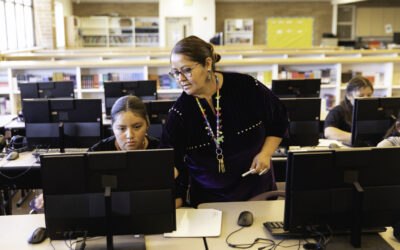I was first introduced to the concept of a technological revolution eight years ago, through a twelve-month professional development course I took about transforming education. It truly upended the way I viewed my role as an educator. Over those twelve months, I took stock of what I – and my colleagues – were currently doing in the classroom, and I came to believe that we were not realistically preparing students for their future.
As a middle school math teacher, I prided myself on using constructivist teaching methods when I could. However, I recognized that the concept of preparing students for a global, technologically based society was so much more than that and not something readily discussed.
What to Teach Today to Prepare Students for Tomorrow’s Workplace
Fast-forward to my first experience in a virtual summit at EdWeek’s “What to Teach Today to Prepare Students for Tomorrow’s Workplace.” I joined author and education leader, Ann McMullan, for a session hosted by Learning.com about readying students for the Fourth Industrial Revolution.
Many of the gaps and challenges I noted almost a decade ago are still there. Schools and districts are making progress, with much room to grow. These successes and challenges were topics in our virtual conference booth. The conversation ranged from hardware challenges to questions about measuring soft skills.
Hardware Challenges
Participant Gemma B was the first to bring up hardware for students. She said that her district has Chromebooks, but that they “don’t feel very career friendly”. Ann reassured her by responding that “schools are in the learning business not the technology business.” As long as they kept the focus on “valid learning experiences,” they would be moving forward.
Another participant added that simply “using tech” isn’t the same as “teaching with tech,” a distinction that others agreed still isn’t clear for many teachers and administrators.
It is true, Chromebooks are essentially a browser with a keyboard. But can they be used to teach students future-ready skills? Absolutely.
When they are used to teach soft skills like collaboration and communication, conduct investigations using online simulations, and address traditional business application skills such as word processing (which can get very advanced), then teachers are teaching with tech and are teaching students the types of skills they truly need to know.
From Basics to Career Readiness
Another theme that came up in the session was a balance between embracing the new without abandoning the basics.
Some in our booth said that they were beginning efforts to integrate and measure soft skills for students but wanted to do this without weakening instruction in the foundations that all students still need, from the core content areas to basic digital skills (i.e. using spreadsheet software). Participant Nettie B wrote that students cannot use a skill in a “transformative way” if they don’t know the basics.
Visitors to the booth expressed a desire to bring in new technology – such as using Esports (video game competitions) as a means to “promote student growth and development,” as Randall F mentioned—without eliminating content-based, instructor-led instruction.
Overall, the takeaway was that teaching students to be successful in a world of technological advancement does not preclude teaching the basics.
All agreed that their goal was to integrate career readiness in ALL classrooms, not just CTE, after-school programs, or advisory classes. Many shared this could be best accomplished through district-wide initiatives in which teachers, parents, and even community members such as business owners are involved in the ideation and implementation.
How to Foster Future-Ready Learning
How can we help classroom teachers like myself to be more successful? What was it that worked for me eight years ago?
The professional development course I took exposed me to a lot of new ideas through books, articles, and class discussions. It also gave me ample time to plan and execute changes within my own classroom, space to receive critical feedback from my instructor, and accountability through my assignments.
Here is a little more about my personal experience.
I started the course in January and completed it in January of the following year. That meant I was able to start trying small things out with classes with which I had already established a relationship and basic classroom routines. Then, I had the summer to process and integrate my experience while I continued to learn from the course.
The following year I was then energized, and able to plan classroom innovations with my new classes starting in the fall. So often we see professional development happening within the confines of a single academic year, but to align with the energy of the teacher, I found this timeline to be effective.
The changes I made in my teaching took a lot of courage and creativity.
The year I took the course, due to budget shortfalls in the district, teachers in their first five years with the district were laid off. I was in year five and sadly had to clean out my classroom and say goodbye to my PLC.
When a new budget was passed at the end of the summer, we were shuffled around and hired back into positions that teachers with more seniority had requested to leave. I was rehired into a position at a middle school with significantly higher student challenges and not enough support. All the teachers I met here had daily classroom management problems.
Social and Emotional Learning
Despite my personal upheaval and new challenges, I was determined to apply what I’d been learning in my class. I first found a mindfulness curriculum to implement. After a few weeks, my 6th-grade math and science classes now started with a short meditation. This contributed to their social and emotional learning and calmed the class down enough to focus.
Problem-Solving and 21st-Century Skills
Many of my students had very low academic self-confidence, so I then started using warm-ups where the students had to generate questions or propose a way to solve a problem, without having to actually come to a solution. This helped build their confidence as there would be no wrong answer while teaching soft skills like creativity, the first steps of problem-solving, and interpersonal communication as they were talking in pairs and in front of the class.
Technology Integration
Then, we started using computers on a regular basis. I got us signed up on a schedule with the laptop carts. We used computers for researching, creating group presentations, writing, and running simulations.
I’m not going to lie; I was nervous about putting the students on computers. As much as I wanted to integrate an authentic use of technology into my teaching, I was concerned about classroom management.
I prepared by asking other teachers who had experience with their students on technology about their classroom routines.
- How exactly did they have students checking computers out and handling the equipment?
- What did they wish they had known before they started?
The first few times we got computers out of the cart, I didn’t even expect the students to complete an assignment. The whole point was to get the routines down.
But I was blown away with the result. My students responded to it all by elevating their cooperation and attentiveness. Students who would literally be physically harming each other otherwise were doing their best to learn and produce.
We weren’t on computers all the time. There was plenty of work with physical manipulatives in math. I requested a Smartboard and designed interactive whole class lessons using that. We did a lot with a good old pencil and paper. After all, the technology exists as a big part of our modern world, not our entire world.
Instruction Reimagined
I felt confident that during that year, I was finally doing more to prepare my students for Tomorrow’s Workplace. Could I have done more? Over time, yes. Change takes time.
So, the same challenges I saw eight years ago are still there, but as I found from the EdWeek Virtual Summit, districts are employing creative measures to meet these challenges. As a community of educators, we are passionate about preparing students for their future, and thoughtful change is happening over the long term
Want to learn more about how Learning.com can help prepare your students to be future ready? Contact us today.

Learning.com Team
Staff Writers
Founded in 1999, Learning.com provides educators with solutions to prepare their students with critical digital skills. Our web-based curriculum for grades K-12 engages students as they learn keyboarding, online safety, applied productivity tools, computational thinking, coding and more.
Further Reading
How Were the TEKS Created & What is Its Significance?
The Texas Essential Knowledge and Skills (TEKS) framework details the educational standards in the state of Texas, providing a comprehensive outline...
CIPA Compliance Made Easy with Learning.com
The Children’s Internet Protection Act (CIPA), enacted by Congress in 2000, addresses concerns about children’s access to harmful online content. It...
Students as Logical Thinkers: How Computer Science Teaches Real-World Skills
There is little debate that computer science education has become an imperative curriculum for future-ready students. From modern professions and...




